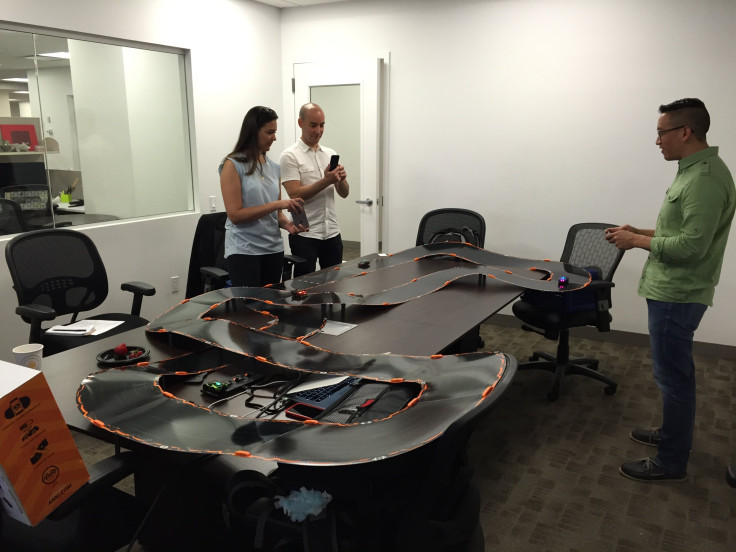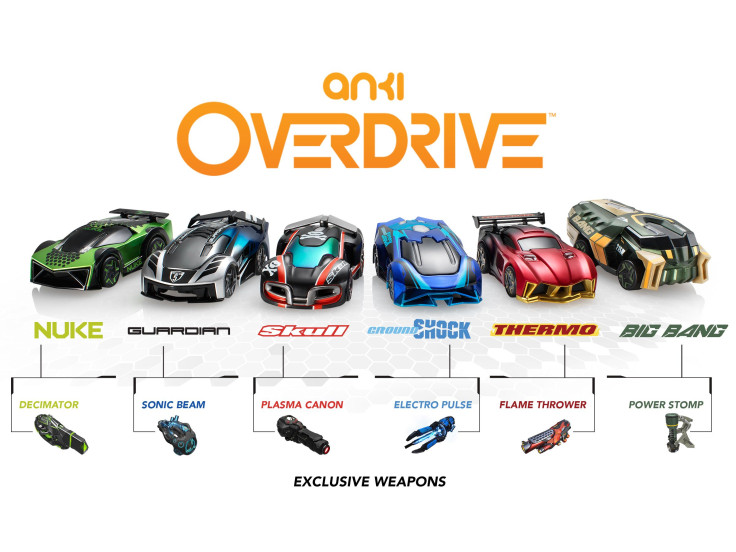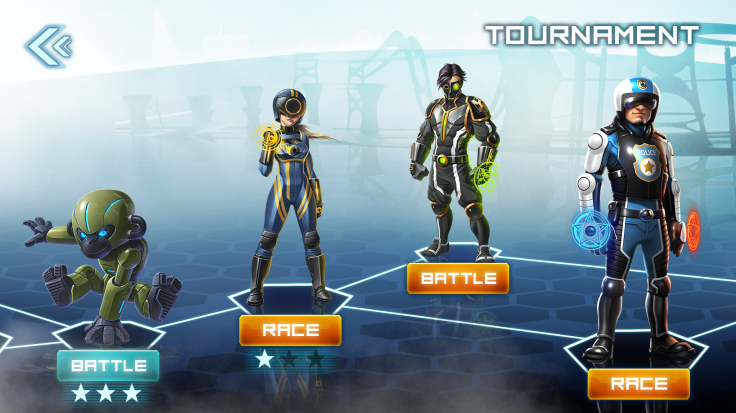Anki Overdrive Robot Cars Bring Artificial Intelligence To Slot Car Racing

Remember electric slot cars, the ones that invariably flew off the track? They’re getting a major tech update. Just when it seemed all toys were going virtual (think Legos for Minecraft), one company is attempting to combine artificial intelligence with physical race cars that have video game-like personalities and capabilities.
Meet Anki Inc., a robotics startup founded in 2010 by grad students who met while studying for their Ph.D.s at Carnegie Mellon University’s Robotics Institute. Their pitch? Robotics as a consumer application. Its first product is a reimagination of remote-controlled cars that have video game-like personalities and capabilities, a toy for the "World of Warcraft" generation.
In 2013 the company debuted a nascent version of the product, Drive, at Apple’s WWDC conference in 2013. Today Anki has over 100 employees and is upgrading the experience of Drive in its new product, Overdrive, bringing video games to life through robotics. Overdrive has a modular track, updated robotics cars and a video game app that work together to create a next-gen racing experience. Through the video game app, which also acts as the controller, players choose from a variety of drivers, known as "commanders," each with its own personality and backstory.
“One of the things we realized is that we can take a lot of the magic of the video game world and apply that to physical characters,” said co-founder and chief product officer Mark Palatucci.
The player can now also create his or her own track using the pieces provided, and using technology the cars map out the world before starting the race. The video game component allows players to progress through the game storyline to win the tournament and become the Overdrive champion or race against each other or computers in a variety of different game modes.
To create a seamless experience for the user the creative team and engineers at Anki had to work closely together, meeting multiple times a week to go over even the smallest of details. As Palatucci puts it, “Right now you can think of Anki really as a game studio operating within the broader robotics company.”
So how does it all work? International Business Times sat down with leading team members at Anki to discuss the process behind the track, the cars and the video game in-depth.
The Cars

Each of the cars is a robot, made of around 30 components. Through technology and algorithms each one knows where on the track it is positioned, its trajectory, how fast it is going and where the other cars are on the track.
This is possible thanks to the infrared camera on the bottom – which takes 500 pictures of the track every second, relaying the information back to the smartphone or tablet – meaning that they rarely go off the track, allowing for more control by the player. The lower-resolution camera is the same one seen on the front of many smartphones, with a few tweaks from the Anki team so that it takes more pictures in a smaller area, they also have a custom lens to focus light in the right way.
Each car has a 500MHz computer in it, which helps with processing the information it is reading from the special pieces of track. The cars also have wireless Bluetooth low-energy chips that auto-detect devices. The Anki team used low-energy chips to predict latency and because they have low battery usage – a six-to-eight-minute charge can give 20 to 25 minutes of play time.
Two motors, one for each of the rear wheels, help the player control the car. “It’s closer to a tank,” said co-founder and CEO Boris Sofman. “To turn right, you turn your left wheel faster.”
Overall the bodies are pretty much identical, except for the weight balance. “Mechanically the cars are all capable of the same thing; it’s the software that changes the gameplay,” said Sofman. Each of the cars has unique identifiers that allow the software to know what car has which personality and therefore certain characteristics and abilities.
While the physical chassis aren’t very different from the cars in Drive, a lot more work was put into the visual aspect of the cars such as the paint and detailing, they were also given new tires with more traction, “so they can drive a little bit faster,” said Palatucci.
Players can have up to four cars on the track at any one time. The main reason there is this limitation is due to some smart devices currently on the market. “We have a single phone that’s connecting to four devices simultaneously, and if you want that phone to also play a multiplayer game it can also then be connecting to three other devices,” said Palatucci.
The Track
The biggest feedback from Drive was that people wanted to be able to create their own tracks. This posed a problem for the Anki team, as they couldn’t predict what players would create, therefore making it impossible for the cars to use their algorithm to stay on the track and assess the trajectory and speed. After around 50 to 60 prototypes they developed a magnetic modular track that is flexible and bendable so that it won’t break easily.
With the customization problem solved the team then had to work on how to enable the cars to read the track and figure out where they were. They spent years developing a custom ink system that was almost invisible to the human eye. This ink allowed microscopic codes to be printed onto the track, allowing the cars to read the code with their infrared cameras and then process it with the computer to tell them where they are, down to a few millimeters.
“The robots actually have to go and map and explore the world and they kind of do this SWARM exploration,” said Palatucci. “They figure out exactly what kind of track they're driving on, and after they map the world they can then figure out where they are.”
To stop the cars from getting confused about which section of track they are on there are four different versions of every piece, reducing the likelihood that two of the same coded pieces will be used in the design.
The Video Game

To make the video game as good as possible Anki brought in a team of talented people with a background in games to work on the concept and bring the characters to life.
“Audio was a bigger part earlier on than in a normal game development team,” said Joby Otero, former creative director for Skylanders, who was brought on board at Anki full-time in July 2014 as the chief creative officer for Overdrive. “For us all the action is taking place in the real world, in a way that doesn’t provide as much visual experience to the user.”
To combat this disconnect between video game and physical game the team worked on sounds for each of the cars, the different weapons and abilities, the throttle and the commanders. This allows players to know what is going on without looking at their screen so they can keep watching the track, although it does take a few turns to get accustomed to this style of gameplay.

A script manager was also important for the team; they spent a lot of time discussing personalities of the commanders, their background and who would be likely to band together to form crews.
“They're effectively AI drivers,” said Palatucci. “As you play the game you're not just racing against another car but you're racing against these other personalities, these AI characters, and they have their own voice, they have their own story, they have their own skills, advantages and disadvantages, weaknesses and strengths.”
Throughout the campaign mode the commanders get harder, forcing the player to try out different strategies, cars and drivers to beat each one.
“The fictional commanders come from all different walks of life,” said Otero. “From professions that make heavy use of vehicles but might not have raced, some you might expect, like police officers or military crews. It creates a rich sense of a world that has all different types of characters.”
Each character also has different quirks and interacts differently with the cars. “In the world the cars are even bigger stars than the commanders themselves,” said Otero. “Most of the commanders respect that and want to bond with the different cars, and some are just about winning and push the cars beyond their limits just to win.”
To organize these characters and give the game structure the creative team came up with the idea of the tournament, bringing in the storyline to give players a larger goal rather than just fighting a commander in a certain type of match and moving on to the next one.
An integral part of the creative team, Sean Levatino, is the lead game designer, and joined Anki in April 2012. Having worked on games before, Levatino found the unpredictability of the track a challenge when designing the game.
“As a game designer, I fall into a default trap of trying to create a perfect experience and controlling all of the variables,” said Levatino. “With Overdrive I learned very quickly that I can’t do that and things aren’t going to be perfect."
Some of these tools include a new upgrade system. Players earn new items through winning games and receiving loot crates; they can then equip these in the garage section of the app and can be used in the campaign and in the open-play mode. If a new player is joining a game with people that have more experience and upgraded cars, there is also a balanced mode in open play to make the field even and strip away upgrades.
It is also possible to combine different types of devices in one game, so if one player has an Android phone and another has an iPad it is still possible to play together. This is important because the phone runs the whole game engine while the AI coordinates the actions of the different vehicles.
“In terms of higher level cognizance, knowing when to shoot, how to steer, how to line up, all of that has to be happening inside the mobile devices because they’re leading the gameplay,” said Sofman.
What's Next?
Overdrive will be released in the U.S. on September 20. The base-kit, which includes two cars, the four-car charger and 10 pieces of track costs $150. More cars, pieces of track and different types of track will be available between $10 and $30 depending on the pack. If you purchased Drive a software update will allow the cars from that game to be used in Overdrive.
Anki however is already thinking to the future, in the next year it has a lineup of new accessories to launch and software updates for the app will be free, allowing access to new commanders, campaigns and items over the following months and years.
Based out of San Francisco Anki received around $10 million from investors Two Sigma during their Series A in 2012.
“Overdrive is going to continue to be a really important product line for the company,” said Palatucci. Anki also plans on using the technology developed for Overdrive in other products and consumer applications. “All of these capabilities are not just customized for a racing game,” said Sofman.
This is just the foundation, the tip of the iceberg.
© Copyright IBTimes 2025. All rights reserved.



















